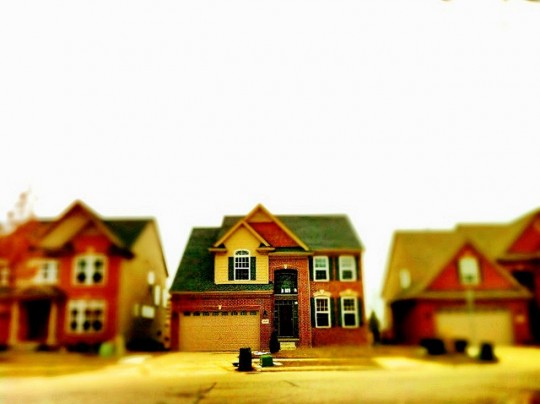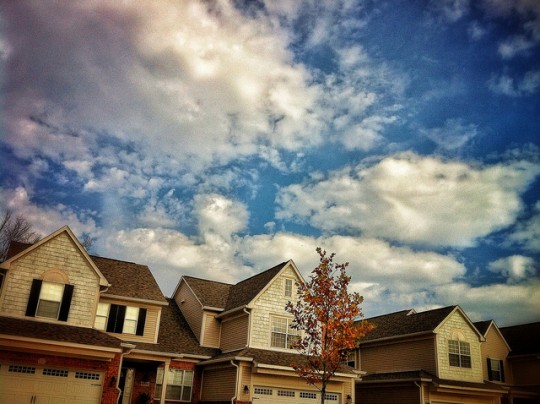As of March 2013, only 34 percent of adults between the ages of 18 and 32 headed their own household. And that number has barely changed since last year, according to a recent report from the Pew Research Center. The lack of improvement in the rate of household formation among young adults has little to do with housing conditions, however. Record affordability and historically low mortgage rates have done little to reverse the high number of Millennials still living in their parents’ home. The reason more than a third of young adults are still living at home four years into an economic recovery is directly related to the job market. This year, 40 percent of employed young adults headed their own household, compared to 25 percent among unemployed Millennials. As the number of employed young adults rises, so to will the household formation rate and number of first-time home buyers entering the housing market. More here.
Archive for November 2013
Gridlocked Government Grinds At Consumer Sentiment
Americans’ perception of the economy and housing market took a big blow during October’s government shutdown and debt ceiling debate. According to the results of Fannie Mae’s October 2013 National Housing Survey, sentiment suffered record losses from the previous month’s results. For example, the number of Americans who said it is a good time to buy a house experienced the largest one-month change in survey history, falling to 65 percent. The number of people who feel the economy is on the right track also set a survey record for monthly change as it dropped 12 percentage points from September. Doug Duncan, Fannie Mae’s senior vice president and chief economist, said the results suggest that consumer attitudes are highly responsive to ongoing debate and decision-making in Washington. Still, because the majority of respondents were polled during the shutdown, the data may reflect a temporary surge in economic pessimism. Over the long term, governmental gridlock is not expected to derail the housing market’s recovery. More here.
Mortgage Rate Rise Stalls Loan Demand
According to the Mortgage Bankers Association’s Weekly Applications Survey, the average contract interest rate for a 30-year, fixed-rate mortgage spiked last week following consecutive weeks of decline. The increase slowed total mortgage application demand by 1.8 percent. Refinance activity was down 2 percent from one week earlier, but as a share of total mortgage loan volume remained steady. Also, the purchase index, which measures demand for loans to purchase homes, fell 1 percent. The MBA’s survey covers 75 percent of residential mortgage applications and has been conducted since 1990. More here.
October Housing Scorecard Shows Progress
The U.S. Department of Housing and Urban Development and the U.S. Department of the Treasury compile a comprehensive report on the housing market each month in an effort to track the progress of the federal government’s recovery efforts. The Housing Scorecard tracks key market data as well as programs aimed at providing relief to homeowners still recovering from the housing crisis. In October, the data shows important progress in home prices, new home purchases, and existing home sales. Kurt Usowski, HUD Deputy Assistant Secretary for Economic Affairs, said homeowners’ equity is at its highest level since 2007 and home prices continue to improve, both indicating that things are moving in the right direction. Since the beginning of 2012, equity is up 50 percent or $3.1 trillion. More here.
New Home Market Strong Among Buyers Over 55
A recent survey of builders shows increasing confidence in the market for new homes among buyers over the age of 55. According to the National Association of Home Builders’ latest 55+ Housing Market Index, significant gains were made in the third quarter as compared to the third quarter of last year. The index found confidence in the market for single-family homes, rose 14 points to its highest third-quarter number since the survey began in 2008. It also represents the eighth straight quarter of year-over-year increases. Robert Karen, chairman of NAHB’s 50+ Housing Council, said there has been steady improvement in the 55+ housing sector as buyers are attracted to new homes and communities that offer the lifestyle they desire. All components of the survey gauging interest in single-family homes experienced double-digit increases over last year. The survey asks builders to rate current sales, expected sales, and traffic of prospective buyers on a scale where any number over 50 indicates more builders view market conditions as good than poor. More here.
Price Increases Starting To Slow After Big Gains
The results of Trulia’s most recent Price Monitor found home prices have increased faster than normal on a monthly, quarterly and yearly basis when compared to historical averages. In fact, home values have risen nearly 12 percent over the last year, which is the highest increase since the housing bubble burst. But despite the year-over-year gains, October asking prices were up just 0.6 percent from the month before. Jed Kolko, Trulia’s chief economist, said – though asking prices rose at the second-slowest pace in seven months – they are still rising unsustainably fast. Kolko cautions that, while the market is far from bubble territory, the effects of fast-rising prices will be noticeable, including sellers waiting longer to put their homes on the market. Trulia’s Price and Rent Monitors are the earliest leading indicator of trends in rent and home prices. More here.
Mortgage Demand Slides Despite Rate Drop
According to the Mortgage Bankers Association’s Weekly Applications Survey, the average contract interest rate for a 30-year fixed-rate mortgage with a conforming loan limit fell again last week. But despite another drop in the average interest rate, applications for home loans decreased 7 percent from the week before. Refinance activity tumbled 8 percent and demand for loans to purchase homes was down 5 percent. The refinance index is up slightly over the past two months, but the purchase index is down about 3 percent according to its 4-week moving average. The MBA’s survey has been conducted weekly since 1990 and covers 75 percent of all U.S. residential mortgage applications. More here.







